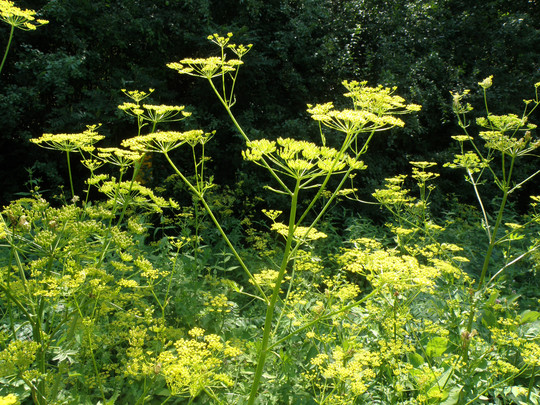|
Having trouble viewing this email? View it as a Web page.
December 6, 2021
December Weed of the Month: Noxious Weed Grant Achievements
Emilie Justen, Minnesota Department of Agriculture
Since 2017, the Minnesota Department of Agriculture (MDA) has awarded grants through the Noxious Weed and Invasive Plant Grant to counties and municipalities. With support from the Minnesota Legislature and the Environmental and Natural Resources Trust Fund, the MDA has awarded over $1.2 million to 120 projects to mitigate the spread of noxious weeds and invasive plants.
Through these grants, the MDA has seen many positive impacts not only with reductions of weed infestations but also increased coordination between municipalities and private landowners who become motivated to treat infestations on their own lands.
One group that came together to focus on mitigating wild parsnip infestations is the Cannon Valley Noxious Weed Group (CVNWG). The CVNWG encompasses four townships in Rice and Dakota counties: Bridgewater (Rice), Northfield (Rice), Greenvale (Dakota), and Waterford (Dakota). John Holden from the CVNWG says that, “when [Bridgewater] started, we were focused on treating wild parsnip.” Over the years, the group found that treatments alone would not be the most effective approach to ridding these townships of wild parsnip. Holden says, “as we progressed, we realized how little the public knows about wild parsnip and we shifted our main goal to educational tools and processes.”
The group took a new approach and focused more on outreach and education, starting with county and state highway departments. “We met with Rice County staff, then MNDOT roadside staff, and our purpose was to educate and get better cooperation. [CVNWG] taught county and state highway staff what we learned about managing wild parsnip, and as a result they improved their management of wild parsnip along roadsides.” Holden adds that, “we realized if we don’t try to get cooperation between our neighboring townships, wild parsnip would keep spreading. With more collaboration, our outreach was to a much wider audience and helped the whole process [of mitigating wild parsnip].”
 An infestation of wild parsnip.
Click here to download the photo
Private landowner engagement has also been a key component to grant recipients’ success with managing noxious weeds. Grant recipients who work with private landowners face a different set of challenges than recipients who focus on roadsides or public lands. Landowners may not be aware that a noxious weed is growing on their property, and many lack the technical knowledge, tools, or physical ability to treat or manage noxious weeds. These grants facilitate connections and provide resources to help landowners who need assistance.
Justin Townsend, Environmental Resources Specialist for Ramsey County Parks and Recreation, sees positive impacts when assisting private landowners. The county does not have the resources to manage noxious weeds on private lands but was able to use MDA grant funds to help landowners. To improve landowner engagement, the county works with landowners to train them to identify and manage noxious weeds on their own properties. In addition, Ramsey County does outreach through partners and is able to reach neighborhoods that have historically been underserved. “We’re making sure outreach and knowledge for technical expertise is reaching every neighborhood,” Townsend says. “We’re going into neighborhoods that have been completely ignored and treating weeds like knotweed.” Knotweed is a large aggressive weed that can grow through asphalt and concrete and is notoriously difficult to manage, so assisting landowners prevents the plants from spreading and doing more damage. This goes a long way toward achieving the MDA’s mission of protecting the environment.
Townsend also says that, “the [grants] themselves have been amazing to work with; one of the best run grants Ramsey County has dealt with. We have a plan in place, but the breadth of the grant allows us to be flexible enough to address changes as they come up.” Townsend adds that, “the dollar amount is not an insignificant amount and allows continuity in treating these sites so we can be the most effective we can be.”
After the CVNWG began finding success cooperating with county and state highway staff, they turned their focus to private landowner engagement as well. Holden says, “many private landowners were also unaware of wild parsnip [and the harm it can cause]. Instead of relying on noxious weed law enforcement, we’ve started doing more education on managing wild parsnip. The key thing the grant did was provide us resources to educate public and private landowners.”
Across the state, grant recipients have worked on collaborative projects with other counties or municipalities, numerous private landowners, and have developed locally relevant outreach materials. The impacts of the Noxious Weed and Invasive Plant Grant go beyond the number of acres or roadside miles treated. Communities come together to solve weed problems, working to protect our urban landscapes, farmlands, and natural resources.
MEDIA: For more information on Weed of the Month, contact Allen Sommerfeld, MDA Communications, at allen.sommerfeld@state.mn.us or 651-201-6185
|